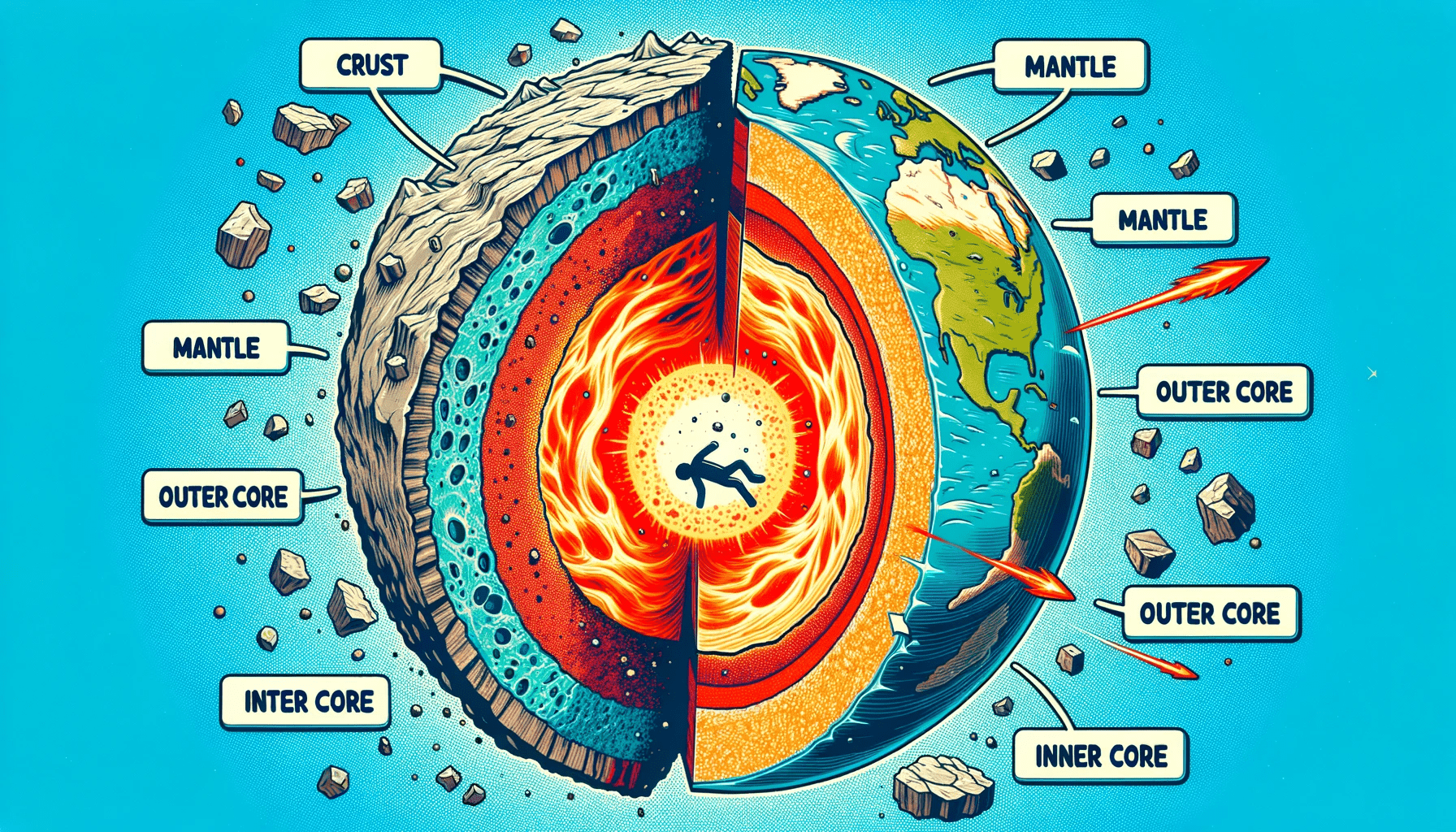Have you ever wondered what would happen if you took a plunge straight through the center of the Earth? It’s a mind-boggling scenario that has intrigued scientists, adventurers, and the curious alike for centuries.
In this article, we’re diving deep into the heart of our planet, unraveling the mysteries of gravity, Earth’s layers, and the extreme conditions you’d encounter.
We’ll tackle the practicalities, the safety concerns, and even the cultural and historical aspects of this fascinating hypothetical journey. So, buckle up and get ready for a ride through the center of the Earth, armed with insights, facts, and a touch of adventure!
Unraveling the Science of Gravity and Earth’s Structure
Understanding the fundamental forces and structures involved in this hypothetical scenario.
Gravitational Forces and Their Role
Gravity, a force we’re all too familiar with, plays a pivotal role if you were to imagine falling through a hole that goes right through the Earth’s center.
Sir Isaac Newton was the first to give us a comprehensive understanding of gravity, and it’s his principles that we’ll delve into to grasp what would happen in such a scenario.
So, let’s break it down. Gravity is the force that attracts two objects with mass toward each other, and it’s what keeps us grounded, quite literally. Now, if you were to fall into a hole through the Earth, gravity would pull you towards the center.
But here’s the kicker: as you pass the Earth’s core, gravity from the other side of the planet would start to slow you down, eventually bringing you to a stop right at the center.
This is what we call a gravity tunnel, a fascinating concept that shows just how intriguing gravity can be.
Journey Through Earth’s Layers
Now, let’s take a vivid journey through the Earth’s layers that you’d encounter while on this hypothetical fall. First up, the crust. It’s the outermost layer, relatively thin and solid.
Next, we dive into the mantle, a thick layer of hot, solid rock. It’s like the filling in a cosmic sandwich, and it makes up a whopping 84% of Earth’s total volume.
As we go deeper, things heat up. We reach the outer core, a sea of molten iron and nickel. It’s so hot and under so much pressure that the metals here are liquid. And finally, the inner core.
It’s solid, scorching, and under immense pressure. Despite being at the very center of our planet, it’s as alien as a distant star.
The Physics Behind Falling Through the Earth
Now, for the physics enthusiasts out there, let’s talk about the nitty-gritty of falling through a gravity tunnel. Imagine you’re in a vacuum, meaning there’s no air resistance.
In this case, you’d be in free fall, accelerating due to gravity until you reach the center of the Earth.
But here’s where it gets interesting. As you fall, the gravitational force decreases, and by the time you reach the center, gravity is zero.
You’re weightless! But don’t get too comfortable, because gravity from the other side of the Earth starts to slow you down, acting like a cosmic brake.
This dance with gravity continues until you reach the other side of the Earth, assuming you could somehow magically pass through the solid layers.
And that, dear reader, is the fascinating journey of falling through a gravity tunnel, a ride governed by the laws of physics and the relentless pull of gravity.
The Hypothetical Journey Down the Earth
Detailing the stages of the journey, from the moment of the fall to reaching the other side.
The Early Stages and Initial Conditions
Imagine standing at the edge of a hole that goes straight through the Earth. You take a deep breath, and you’re off! In the early stages of this thrilling yet hypothetical fall, air pressure plays a crucial role. As you plummet down, the air around you becomes denser, and the pressure increases.
This isn’t just a gentle squeeze; we’re talking about a force that can have significant effects on your body, potentially leading to hyperoxia, a condition where your body takes in more oxygen than usual.
But let’s not get ahead of ourselves. The initial conditions of your fall are vital to understand. You’re accelerating, the wind is rushing past you, and for a moment, it’s an adrenaline-pumping free fall.
It’s in these early moments that you truly start to grasp the immediate effects of your daring adventure.
Traversing the Crust and Mantle
As you continue your descent, you bid farewell to the familiar world above and dive into the Earth’s crust. It’s rocky, it’s solid, and it’s just the beginning.
The temperature starts to rise, and the pressure builds up. You’re not just falling; you’re traversing through geological history.
Next up, the mantle. It’s vast, it’s hot, and it’s unlike anything you’ve ever imagined.
The conditions here are extreme, with temperatures and pressure increasing as you go deeper.
The mantle is a testament to the Earth’s fiery nature, a layer that holds secrets of our planet’s past and present.
The Extreme Conditions of the Earth’s Core
And now, the grand finale of your journey: the Earth’s core. First, the outer core. It’s a sea of molten iron, churning and swirling.
The temperature is off the charts, and the pressure is unimaginable. But it’s also mesmerizing, a glimpse into the heart of our planet.
Then, the inner core. It’s solid, it’s hot, and it’s under pressure like you wouldn’t believe. The conditions here are extreme, to say the least.
You’ve reached the center of the Earth, a place of molten metal and fiery secrets.
And as you pass through, you realize that this journey, this hypothetical fall, has taken you through layers and conditions beyond imagination.
From the early stages of the fall to the heart of the Earth, it’s been a ride like no other.
Theoretical Considerations and Fun Facts
Exploring the cultural, historical, and scientific aspects of the hypothetical scenario.
Cultural and Historical Depictions
The idea of tumbling through the Earth has tickled human imagination for centuries, weaving its way into our stories and myths. Jules Verne, with his classic “Journey to the Center of the Earth,” brought this fantastical concept to life, inspiring generations to ponder the mysteries lying beneath our feet.
His tale, filled with adventure and wonder, is a testament to the enduring allure of the unknown.
But it’s not just in literature where this idea has found a home. Myths and legends from various cultures have played with the idea of underworlds and hidden realms deep within the Earth, showcasing our fascination with what lies beneath.
These stories, passed down through generations, highlight our innate curiosity and the desire to explore the unknown.
Scientific Theories and Experiments
Now, let’s put on our lab coats and delve into the scientific side of things. The world of physics has been buzzing with theories, experiments, and studies aiming to unravel the mysteries of gravity, falling, and the Earth’s structure.
Physicists have been hard at work, conducting gravity experiments and proposing hypothetical scenarios to better understand the forces at play.
These scientific endeavors provide us with a framework to not just imagine, but also to analyze what falling through the Earth would entail.
From understanding how gravity works to exploring the Earth’s layers, science offers us a way to turn this fantastical journey into a series of intriguing questions and explorations.
Real-Life Incidents and Analogies
But what about the real world? Are there incidents or analogies that can bring this hypothetical scenario closer to home? Absolutely! Gravity, the force that would govern your fall, is at play all around us, from the way we walk to how objects interact.
There have been real-life incidents and experiments that shed light on gravity’s influence, providing tangible examples and connections.
These stories and analogies help bridge the gap between the hypothetical and the real, offering a grounded perspective on a scenario that, at first glance, seems to belong solely to the realm of imagination.
Practical Implications and Safety Considerations
Addressing the safety, survival aspects, and the technological challenges of creating a hole through the Earth.
Safety and Survival in the Hypothetical Fall
Now, let’s talk about the elephant in the room: would you actually survive a fall through the Earth? Spoiler alert: it’s complicated. Safety and survival in such a scenario are, to put it mildly, challenging.
You’d need some serious protective measures and equipment to even stand a chance.
Imagine the intense heat, the crushing pressure, and not to mention the need for oxygen. You’d need a suit that’s more advanced than anything we currently have, something that can withstand conditions that are, quite literally, out of this world.
It’s a wild ride, and ensuring survival would require addressing a myriad of safety concerns and potential hazards.
Technological and Engineering Feats
Creating a hole through the Earth? Now that’s a monumental task. We’re talking about drilling through layers upon layers of rock, molten metal, and more.
The technological and engineering challenges are immense, requiring advancements and feats that go beyond our current capabilities.
From the drilling technology to the materials used, everything would need to be top-notch and beyond what we currently have in our arsenal.
It’s a task that pushes the boundaries of engineering and technology, challenging us to innovate and think outside the box.
Ethical and Environmental Considerations
But wait, there’s more. Drilling a hole through the Earth isn’t just a technological challenge; it’s an ethical and environmental conundrum.
What would be the impact on our planet? How do we ensure that we’re not causing irreparable damage?
These are questions that require careful consideration and impact assessment.
It’s not just about the thrill of the journey or the technological triumph; it’s about being responsible stewards of our planet, ensuring that we’re protecting the Earth for future generations.



